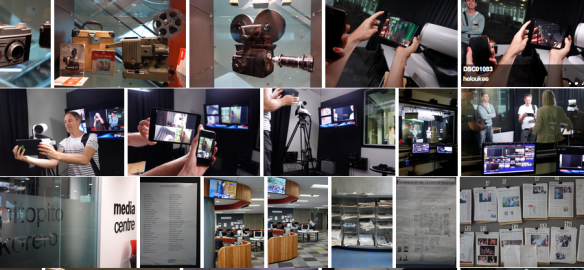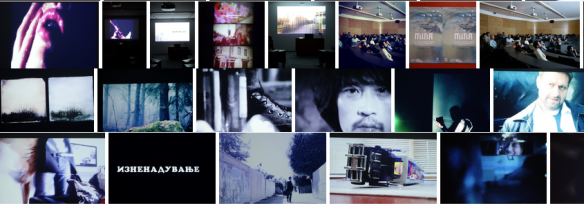(and a title so long it reminds me a really must sort out my WP template…)
Oz/NZ Week Three
Many of the contributions to last week’s MINA 2013 Mobile Film Screenings and Symposium explored locative media and geo-located production practices. Carrying on the same theme, for the past week I’ve working alongside iCollab/ELVSS collaborators Thom Cochrane and Laurent Antonczak, with the welcome addition of Vik Narayam from AUT. We’ve been running a series of Mobile and Augmented Reality Film Workshops (#marmw2013) for academics from AUT and beyond.
It’s been a packed week, where we’ve covered many aspects of mobile/locative media creation with guest speakers from around the world dropping in via Google Hangouts. Together we’ve explored collaborative mapping and augmented reality applications (similar to the recent #iCollab project); collaborative movie making using Vyclone; Vine and a range of mobile film apps; Vimeo and YouTube (or rather Vimeo vs. YouTube); mobile film history and aesthetics; mobile filming techniques; mobile audio production tools and practices; and transmedia narratives for audience engagement.
Guest speakers via hangout included:
- Vernon Rive (NZ but currently at Cambridge University in the UK) – as an environmental lawyer, Vernon’s use of social/mobile media in his casework is a real eye-opener as he uses online platforms to highlight community issues in relation to legal cases. This led to Averill Gordon musing on the blurring of boundaries between law and PR if lawyers are using digital media to engage people/raise awareness of campaigns – reminding me of Ron Burnett‘s writing on transdisciplinarity in networked spaces, which I find myself referring to on a regular basis, including in our paper “New Global Learning Cultures: Interdisciplinarity through Networked Technologies“
- “The Swedes” (Sweden, funnily enough) who told us about the ways they’re using mobile and social technologies at Umea University – they’re wonderful, as is Thom’s blog post which tells you more about them…
- Dan Wagner (UNITEC, NZ) who gave us a live demo of filming techniques (from the great outdoors – well the lush grounds of UNITEC at least – complete with a serendipitous tui birdsong accompaniment) particularly focusing on the technical capabilities/limitations of camphone lenses.
- Everybody’s favourite German mobile filmmaker Max Schleser (Massey University, NZ) who gave us an entertaining yet erudite perspective on mobile filmmaking, including a sample of his mobile-mentary “Frankenstorm“, filmed at the Jersey Shore, two month after hurricane Sandy hit the East Coast and caused an estimate of over $71.4 billion in damage.
- Catherine Cronin (Ireland) – a member of the iCollab team, who talked about our international collaborative google mapping project, raising important issues around trust and identity in online networks. It’s always good to hear Catherine’s graceful musings on learning and teaching through social and mobile media…
- Finally, Mark McGuire (University of Otago, NZ) joined us on Friday afternoon and gave a rich overview of digital media practices and possibilities before spending time talking to each participant individually about their projects, which was much appreciated and ensured that people went away brimming with ideas.
While the workshops ran Monday to Friday, we also spent part of the day on Wednesday at the AUT Journalism Symposium, where Thom was presenting on the use of mobile technologies in L+T and I was a panellist (Innovation and The Future) along with Jeremy Rees (Editor-In-Chief, APN-online/NZ Herald) and Richard Pamatatau, expertly mediated by Helen Sissons, where we discussed, debated and occasionally disagreed on the role and impact of social media on mainstream journalism.
Danni Mulrennan, who organised the Symposium (and is doing great stuff with mobile/social in journalism ed.), also gave us a tour of the fantastic journalism facilities at AUT. Myself and Laurent had a great time playing around with the VidyoCast system and making… erm… screen art…
All in all it’s been a packed week, and we’ll be seeing the workshop participants again on 5 and 6 December to view their individual/group projects, which I’m really looking forward to.
Here is the G+ Community for the workshops, which gives an idea of the kind of things we’ve been covering, and for a visual summary see this Flickr set.


